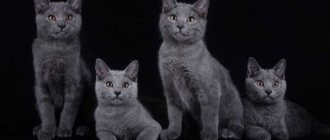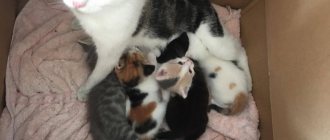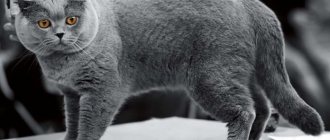History of the Cymric breed
The Cymric, or Welsh cat, is considered an indigenous breed, as it was formed in the wild with minimal human intervention. The history of the breed began back in the 11th century on the Isle of Man, when cats were brought there to fight small rodents. Until the 16th century, new animals constantly arrived on the island and interbred with the purrs already living on it. As a result of a natural mutation, tailless short-haired cats - Manxes - appeared on the island. They interbred extensively with British and Norwegian forest cats. Thanks to this, some tailless animals got fluffy coats. Later they were taken to Wales, where even more Norwegian cats lived. This is how the long hair became permanently established among the future Cymriks. But regardless of the length of their fur, all tailless cats were called Manx.
Cymric means "Welsh" in English.
In the 1960s, Manx tailless animals came to North America, where they were actively selected. Short-haired and long-haired cats were not separated and considered one breed. But if everything was successful with the selection of the first, then difficulties arose with the second: in most cases they were born with tails, and the mortality rate of kittens was very high. Through experience, breeders have found that the tailless gene is recessive in long-haired Maine natives, and dominant in short-haired ones. It was then that the Canadians decided to fight for the right of the Cymric to be a separate breed. The activists were breeders Leslie Foltsake and Blay Welsh. In 1976 they achieved championship status for Cymrics from one small club, Lovebunny Cattery. After some time, the breed was recognized throughout America, and the Lovebunny Cattery became the International United Cymric Association.
Previously, Cymrics were considered long-haired Manx.
Origin story
The birthplace of Cymric is the small Isle of Mans near Great Britain. The first mention in sources dates back to 1750. Close relatives of the Cymrics, the Manx, also appeared on the same island. However, despite the external similarity, these are different breeds, and it is a mistake to believe that the fluffy Cymric is a long-haired Manx. Local residents jokingly call Cymrics a cross between cats and rabbits due to the complete absence of a tail. But this is the result of a complex genetic mutation that appeared a long time ago (more than four hundred years ago).
The tailless cats that were born did not correspond with anyone and continued to mate with each other (since the island was considered closed for a long time, representatives of other cat breeds were not brought there).
This type of mutation is called the “bottleneck effect” by geneticists, but the length of the appendage in kittens from the same litter may be different. Currently, this feature is supported by the works of breeding breeders.
In 1960, amazing tailless babies came to Canada, and that’s where they began to gain popularity. However, they were recognized as an independent breed only in 1967, and even then, some authoritative organizations still refuse to recognize them and still believe that the Cymric is just a type of Manx.
There are few nurseries engaged in breeding Cymrics. In Russia and neighboring countries there are none at all, so purchasing a kitten is an extremely expensive and troublesome matter.
Breed standard
Cymrik is a medium or large cat (from 3.5 to 6 kg), recognized as a separate breed by the CFA and WCF organizations. Standard:
- The cat's body is dense and rounded with a short back, a rounded sacrum, strong and slightly sunken sides, strong and muscular thighs.
- The forelimbs are set wide apart and the bones are massive. The hind legs are longer than the front ones.
- The back arches from the shoulders to the sacrum.
- The paws are round and neat.
- The head is large and round, the cheekbones protrude.
- The neck is thick and the chin is strong. The nose is medium, graceful bridge.
- The vibrissae pads are round in shape, with a clearly visible depression at the base of each vibrissae.
- The ears are large and wide, slightly narrowing and pointed at the tips, set high on the head, and have tassels at the ends.
- The coat is double, medium or long.
- The undercoat is thick and soft.
- The coat is very silky and shiny.
- Many colors are allowed, as well as their combinations, for example, white and tabby. But chocolate, lilac and Siamese colors are not allowed by the standard, as well as their combinations with white.
- The tail is completely absent, there is a depression at the end of the spine. A residual tail is a defect.
- The eyes are large, round in shape and very expressive, located at an angle to the nose (the inner corner of the eye is slightly lower than the outer).
The main difference between the Kimra cat participating in exhibitions is the complete absence of a tail. The cat should be shaped like a hare, it has a short back, long hind legs, and its paws form a square with its body.
Cymrik can be any color except color point, lilac and chocolate
Types of tailings
In total, the Cymric has four types of tail:
- rampi - complete absence of a tail, in its place there is a small hole, such cats are the most valuable;
- riser - 1–3 vertebrae, a length of no more than 2 cm is considered acceptable, for a longer length the cat will be disqualified;
- Stumpy - tail from 4 to 13 vertebrae, can be twisted, broken or with knots;
- Longies are a common cat's tail, but slightly shorter than those of the tailed breeds.
Stumpy and Long cats do not participate in exhibitions, but are used in breeding.
Photo gallery: types of Cymric tailings
The rampie type involves the complete absence of a tail
The Stumpy's tail is very similar to that of the Bobtail.
The longi tail is not much shorter than a regular cat tail. The riser tail type is almost invisible under the fur.
Character
Hunting and protecting their territory was what the wild ancestors of the Cymric did, living in small groups of one male and a pair of females. This cat is brave and even a little reckless when it comes to protecting her home and “pack” from potential danger. If the owner is afraid of something or angry with someone, the Cymrik is not afraid to attack - be it a dog, a cat, or even a person.
The animal is balanced and calm. His favorite pastime is to climb higher and proudly survey his “possessions.” When the owner is busy, the Cymrik prefers to sleep, but is not against games and affection. He adapts to the character of his owner: he will not cause any trouble for people who love peace and quiet, and with active owners he is ready to play and even walk on a leash.
Cymrics love hunting
With age, the character of the Cymric changes to more lazy and phlegmatic. The old cat will not play and frolic, but will remain just as affectionate and brave. The breed is tolerant of small children. It will get along with other pets only if they are friendly. The Welsh cat is not suitable for busy people, as it cannot stand loneliness: it is important for her to be in a pack all the time.
The peculiarity of the Cymric is the ability to quickly adapt to changes in environment, a calm attitude towards travel and a love of water. He doesn't like to swim, but to look at the flowing water and fish. Therefore, you need to protect the aquarium from the cat: a Cymrik will not miss the opportunity to feast on fresh fish.
Cymriks cannot stand loneliness
When you pick up a cat, support it with its hind legs. Do not pull the animal's tail, as this causes severe pain. Stroke his rump carefully.
Character and behavior
You can't find more intellectuals like the Cymrics. They are easy to train: they can remember up to a dozen commands, learn to close and open doors, and carry light objects (rolled newspaper, their toys). If you start to accustom your baby to a harness, he will be happy to walk in full gear with his owner down the street. If you give a Cymric a tasty piece, he will never refuse it, even if he is full, but will hide the delicacy in a secret place, away from prying eyes.
Cymriki are not afraid of water, unlike most cats, which is why they love water treatments. This will be a great help for the owner: you won’t have to restrain a cat that is trying to get out of your hands: just lay a diaper on the bottom of the bath and turn on the water warmer.
Individuals of this breed are the best hunters. They are not afraid of mice, rats, or birds, which is a bit of a problem: having parrots or small rodents in the same apartment is risky. If you don't care, you'll have one less pet. And it will definitely not be a Welsh cat!
The speed of the Cymric's reaction is amazing: he can instantly assess the situation and, if something happens, attack an object that seems suspicious to him. Especially if he notices the owner’s concern about this. Therefore, in the same company as him, you should not raise your voice, behave emotionally or show aggression.
What breeds do you prefer?
ShorthairLonghair
But if the cat feels the owner’s calmness, then he himself remains calm and unperturbed. His favorite pastime is being next to his adored owner. It is worth noting that the Cymrik is devoted like a dog: it follows its loved one from room to room, sits on the shoulder or purrs on the lap. Doesn't like noisy companies or loud sounds. Doesn't cry in vain. The Cymric's voice is very pleasant: soft and thin, with an interesting set of sounds and intonations. Extremely curious.
He doesn’t mind playing with a ball or a toy mouse, he’s bouncy and will climb onto any closet and any shelf in the apartment. Therefore, if renovation is important to you: place a large and high cat corner in the room, where the cat can throw out excess energy.
He is attentive and friendly towards children, ready to run around the rooms with them. She cannot stand separation: she becomes very sad, refuses to eat, and may even become seriously ill. Accustom your pet to travel by car or other transport: if you do this from an early age, your cat will be pleasant company for you on your travels.
Expert opinion
Dusheba Vera Ivanovna
In 2010, she graduated from the Moscow State Academy of Veterinary Medicine named after K.I. Scriabin with honors, specializing in veterinary medicine. I regularly attend veterinary conferences, congresses, and webinars.
The cost of a show kitten is approximately a thousand dollars; if a defect is detected, the price is slightly reduced. When choosing a baby, adhere to several criteria: appearance, behavior, availability of documents (passports with information about vaccinations and pedigree) and the health of the kitten. The toddler should have clean mucous membranes, skin without rashes and irritation, ears and eyes without discharge. Bad breath is a sign of stomach problems.
Cymric health
As a native breed, the Cymrik is unusually strong, resilient and healthy. He does not suffer from any heart disease, is not susceptible to infections or colds, and has no intestinal problems.
However, the Cymrics are characterized by some deviations associated with the structural features of their body; This:
- A mutant gene that is responsible for taillessness in Cymrics. It is recessive and penetrative (that is, it may or may not be present in both anurans and caudates). To give birth to healthy kittens, one of the parents must not be a carrier of the gene. If both are carriers, then the offspring will be born dead.
For the birth of healthy offspring from a Cymric, competent selection is important
- Manx syndrome is a dangerous disease that can appear in kittens from birth to 6 months. It manifests itself in shortening of the spine, which leads to hernia, fusion of vertebrae and many other problems. Tailed Welsh cats are much more susceptible to this syndrome. Therefore, breeders often dock the tails of kittens at the age of a week. They do this for other reasons: in tailed Cymrics, at the age of 4–5 years, the spine may stiffen. Cupping at this age is dangerous, but kittens tolerate it without complications.
Manx syndrome affects kittens under 6 months of age
Cat character
Looking at a photo of a Cymrik cat, it’s hard to imagine that she is an excellent hunter. This is how it happened historically and their instincts make themselves felt.
Owners note the animal’s unique watchdog qualities. The cat is very attentive and reacts instantly to any threats. But if the owner does not show concern, the animal immediately calms down.
Overall, the Cymric is a very cute creature. The cat has a calm and balanced disposition. She is playful, cheerful, and accompanies her owner everywhere. It will never interfere with the owner's rest - he will simply settle down next to him and guard his sleep.
The animal is distrustful of strangers. The Cymrik kitten should be around people more often. This is necessary to develop communication skills.
By the way, representatives of this breed love to travel. Taking your pet with you on a trip is a good idea. Moreover, he will be very bored if the owner leaves home for a long time.
By inheritance from their ancestors, the Cymric people inherited a great love for water. They love to watch her, but this does not mean at all that the cat will be delighted with bathing.
Nutrition
Due to its nature, Cymrik needs a low-calorie diet. The diet should contain sufficient protein and as little fat as possible.
Brands of feed for Cymric
Holistic food is best suited for a Welsh cat, but super-premium can also be given. The main thing is not to overfeed the cat.
Top 5 feeds for Cymric:
- Bosch Sanabelle Light. Premium class. Low calorie cat food with 30% protein content. The amount of fat in the feed has been reduced, medicinal herbs and vitamin complexes have been added. Main composition: at least 20% chicken and duck meat;
- yellow millet;
- rice;
- flax-seed;
- dehydrated meat flour;
- marigold flowers;
- yucca extract;
- ground chicory root;
- vitamin and mineral supplements.
- broth - 43%;
- chicken fillet -14%;
- duck fillet - 34%;
- chicken meat - 34%;
Photo gallery: food for Cymric
Carnilove Salmon Grain&Potato Free is a holistic food for cats Orijen Fit&Trim cat food contains fiber and reduced fat 1st Choice Vitality Indoor is one of the most affordable quality cat foods Bosch Sanabelle Light is a low-calorie food product for cats
40% of Carnilove Duck&Pheasant Grain&Potato Free is protein
Suitable for kittens:
- Acana Regionals Wild Prairie Cat & Kitten;
- Orijen Cat & Kitten;
- Carnilove Kitten Salmon & Turkey Grain-Free;
- Wahre Liebe "Junge";
- Duke's Farm Kitten Fresh Duck;
- NOW Fresh Grain Free Kitten Recipe;
- Almo Nature Legend Kitten Chicken;
- ROYAL CANIN Kitten;
- ROYAL CANIN Kitten Sterilized - for sterilized kittens;
- Royal Canin Pediatric Weaning Kitten canned - for kittens up to 4 months.
Natural nutrition
Natural food should also contain a lot of protein and less fat. The main products that a Cymric needs are:
- meat - lean beef, chicken fillet, rabbit - should make up at least 70-75% of the diet, you can add poultry liver, kidneys and heart, give it boiled or boiled;
- porridge - oatmeal, rice, buckwheat - approx. 10–15%;
- vegetables and herbs are required, you can give any, except potatoes, garlic and onions: usually they are ground raw into a paste and added to the main food (for 3 parts of meat, 2 - porridge and 1-2 - vegetable puree), vegetables and herbs should not be less than 10% of the diet;
- cottage cheese and fermented milk products are given 100 g per week, divided into 4–5 servings;
- raw quail eggs - 2 times a week, two, can be replaced with two chicken eggs per week;
- sea white low-fat fish - 3 times a week, 20-40 g, hake is good.
You should not feed your cat human canned food, pork, fatty meat, sweets and sausages. No seasonings are added. Millet and cereals are not suitable for cats. No food from the human table should end up in the cat's bowl.
If fed naturally, the Cymrik will need additional vitamins:
- Excel Brewers Yeast 8 in 1;
- Anivital Feliimmune;
- Beaphar Irish Cal;
- Beafar Top 10 Cat.
A balanced diet is important for Cymric
Care and maintenance
Cymric needs as much space as possible. It will be difficult for him to live in a small apartment. If space allows, it would be a good idea to install playgrounds for cats, cat trees and other structures that will allow your pet to climb to heights. Kimrik loves walks on a leash, so he can be taken outside once every 2 days. The main thing is to accustom him to this from childhood.
Kymrik needs a lot of space, so it should not be kept in a small apartment.
Grooming and washing
The long double coat of the Cymric with a rich undercoat requires regular brushing and washing. To care for your pet you will need:
- combined comb;
- furminator for long-haired breeds;
- bristle and iron comb;
- rubber comb;
- antistatic spray.
It is enough to comb the Cymric once every 3-4 days:
- First, use a comb to smooth out the wool, onto which an antistatic agent is first applied.
- Using an iron comb, comb the wool again.
- Use a rubber brush to remove dead hair.
- Comb the fur with a bristle comb.
During molting, the procedure is repeated every day. Furminator is used after a combined comb and no more than 2 times a week. Cymrik is washed no more than once every 3–4 months with special shampoos.
Photo gallery: shampoos for Cymric
Jerob Herbal Shampoo - herbal shampoo for cats Tropiclean Papaya is designed specifically for long-haired cats Gentle Shampoo for long-haired cats gently cleanses the hair BioGroom Protein-Lanolin Silky Cat makes the cat's coat silky and prevents the appearance of mats Perfect Coat Concentrated Shampoo for cats is used sparingly
Care for eyes, teeth, ears, claws
Not only the fur, but also other parts of the animal’s body require constant care:
- Cymric ears are cleaned using drops and cat ear lotion. First, drops are instilled, the base of the ear is massaged for about a minute, then the auricle is wiped with a cotton pad soaked in lotion. Repeat once every 4–5 days.
- The cat's teeth are brushed once every 2 days. To do this, you will need cat toothpaste and a special toothbrush. Teeth should be brushed gently but thoroughly.
- The eyes are wiped with a piece of natural fabric soaked in a caring lotion for cat eyes.
- The Cymric's claws are longer and harder than those of many breeds, therefore, in addition to a nail clipper, you will need a nail file (not an iron one). First, the claw must be cut off without touching the pink sensitive part, and then carefully sharpened with a file to a rounded state.
Photo gallery: tools for caring for Cymric
A 2-in-1 comb with bristles and teeth smoothes out fur and removes fallen fur. A combination comb removes tangles.
The rubber brush produces a gentle massage and removes remaining hairs. Thanks to BioGroom Finisher AntiStat antistatic spray, the cat's fur does not become electrified during combing. A nail clipper is necessary for nail care
There are special nail files for cats and dogs.
A toothbrush for cats is softer than a human. Ear drops are designed for deep cleaning.
Cymric diseases
In the case of Cymrics, their “taillessness” is dangerous. The gene that is responsible for the absence of this limb can become fatal. So kittens that inherit identical genes are not even born, but die in the womb. Because of this, a small number of kittens are born in a Cymric litter (only 2-3). However, even Cymrics who have inherited only one copy of the gene are predisposed to a disease such as Manx syndrome.
This gene affects not only the tail, but the entire cat's spine. The latter becomes shorter, producing a detrimental effect on the internal organs. To prevent the cat from suffering in the future, kittens with this syndrome are usually euthanized.
This side effect is common in litters. The disease can appear in a kitten in the first month of life, but in some cases its signs are noticeable only at 6 months. In order not to take risks, you need to purchase a kitten from breeders who have all the health certificates of the parents and extensive experience in breeding Cymric cats.
If your pet is outdoors, it will often develop worms. In this regard, it is necessary to deworm the cat once every 2-3 months.
Characteristics of Cymric in the table
| Breed name | Cymric |
| Country of origin | Canada |
| Time of birth of the breed | 1960s |
| Character traits | kind, smart, touchy |
| Weight | 5-8 kg |
| Height (height at withers) | 28-32 cm |
| Lifespan | 12-15 years |
Cymric video
The Cymric cat will make an excellent pet in any family. But most of all, a family with children and other pets will suit her. A cat requires careful care of its fur. The double layer and unusual structure of the hairs will require owners to comb out frequently, otherwise tangles will inevitably occur.
You should also pay attention to choosing a good scratching post before getting this pet. Cymriki love fresh air and walks, but it is worth accustoming them to the street and the promenade on a leash from an early month
This is the most touchy cat breed. They do not like shouting and criticism in their direction. After such incidents, cats may avoid or ignore the culprit for a long time.
It is better to let them be the center of attention, not to raise your voice at the Cymrics and to praise them more often for their successes. A smart cat can be easily trained by teaching it to fetch small objects for its owners or stand on its hind legs.
Cymric Breeding
Kymriks are very rare and few in number. There are nurseries for these cats only in Western Europe, the USA and Canada. It is prohibited to export uncastrated and unsterilized cats to people who do not own a professional cattery. Therefore, it is unlikely that it will be possible to breed these beautiful animals. However, several interesting details of their breeding are known:
- You cannot cross two Cymrics with a rumpy tail, since the offspring are born dead (a side effect of the mutant gene): breeders solved this problem by crossing rumpy cats with longy and stumpy cats.
- The percentage of completely tailless offspring rarely exceeds 25%.
- 25% of kittens die in the first stages of fetal development, so a Cymric never has more than 4-5 babies in a litter.
- Cymrics and Manxes, as related breeds, are allowed to be crossed. The offspring are considered Cymric regardless of coat length. Short-haired Cymrics (which are actually Manx!) are considered pet-class animals, even with a short tail.
Breeding Cymrics is not trusted by beginners and non-professionals











